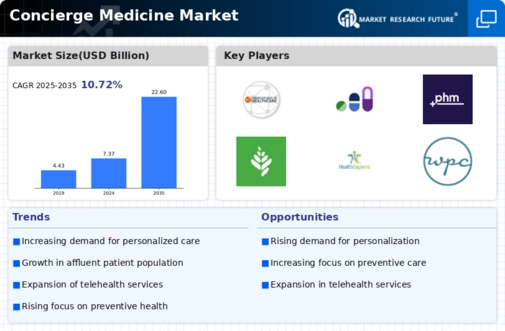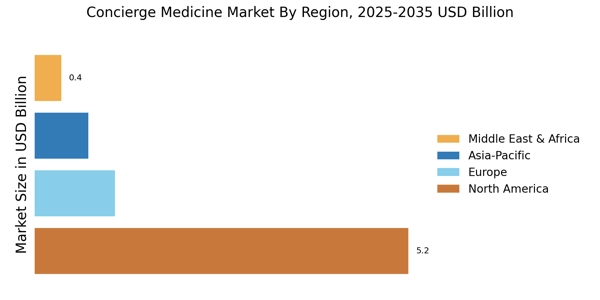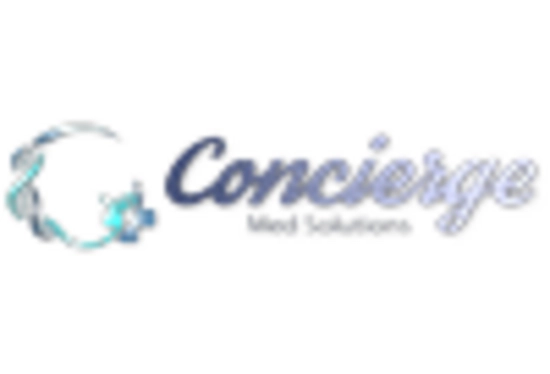Technological Advancements in Healthcare
Technological advancements play a pivotal role in shaping the Concierge Medicine Market. Innovations such as telemedicine, electronic health records, and mobile health applications enhance the delivery of concierge services. These technologies facilitate seamless communication between patients and providers, enabling more efficient management of health conditions. Furthermore, the integration of artificial intelligence and data analytics allows for improved patient monitoring and personalized treatment plans. Market analysis suggests that the adoption of these technologies is expected to increase, with a projected growth rate of 15% in telehealth services within the concierge medicine sector. As technology continues to evolve, it is likely to further enhance the patient experience, making concierge medicine an increasingly attractive option for those seeking comprehensive and accessible healthcare.
Changing Demographics and Aging Population
The Concierge Medicine Market is significantly impacted by changing demographics and an aging population. As the global population ages, there is an increasing demand for healthcare services that cater to the unique needs of older adults. Concierge medicine offers a model that provides enhanced access to care, which is particularly appealing to seniors who may require more frequent medical attention. Additionally, the aging population often seeks personalized care that addresses chronic conditions and promotes overall well-being. Market data suggests that the number of individuals aged 65 and older is projected to double by 2050, indicating a substantial opportunity for growth within the concierge medicine sector. As demographics continue to shift, the industry is likely to adapt to meet the evolving healthcare needs of an aging society.
Growing Demand for Personalized Healthcare
The Concierge Medicine Market experiences a notable increase in demand for personalized healthcare services. Patients are increasingly seeking tailored medical experiences that cater to their individual needs and preferences. This trend is driven by a growing awareness of the limitations of traditional healthcare models, which often prioritize volume over personalized care. As a result, concierge medicine offers a more customized approach, allowing patients to receive focused attention from their healthcare providers. Market data indicates that the concierge medicine sector has seen a steady growth rate of approximately 10% annually, reflecting the rising consumer preference for personalized healthcare solutions. This shift towards individualized care is likely to continue, as patients increasingly value the benefits of having dedicated access to their physicians and a more proactive approach to their health.
Increased Focus on Preventive Health Measures
The Concierge Medicine Market is witnessing an increased focus on preventive health measures. As awareness of the importance of preventive care grows, patients are seeking healthcare models that emphasize wellness and disease prevention. Concierge medicine aligns well with this trend, as it often includes comprehensive health assessments, personalized wellness plans, and proactive health management strategies. This approach not only enhances patient satisfaction but also contributes to better health outcomes. Market Research Future indicates that preventive care services within concierge practices have seen a rise in demand, with many patients valuing the opportunity to engage in health-promoting activities. As the emphasis on preventive health continues to gain traction, concierge medicine is likely to play a crucial role in shaping the future of healthcare delivery.
Rising Healthcare Costs and Affordability Concerns
The Concierge Medicine Market is significantly influenced by rising healthcare costs and affordability concerns. As traditional healthcare expenses continue to escalate, many patients are exploring alternative models that offer more predictable pricing structures. Concierge medicine often provides a subscription-based model, which can alleviate the financial uncertainty associated with conventional healthcare. This shift is particularly appealing to individuals who prioritize access to quality care without the burden of unexpected medical bills. Market data indicates that approximately 30% of patients are willing to pay out-of-pocket for concierge services, reflecting a growing acceptance of this model as a viable solution to rising healthcare costs. As affordability remains a pressing issue, the concierge medicine sector is likely to attract more patients seeking cost-effective healthcare alternatives.


















Leave a Comment